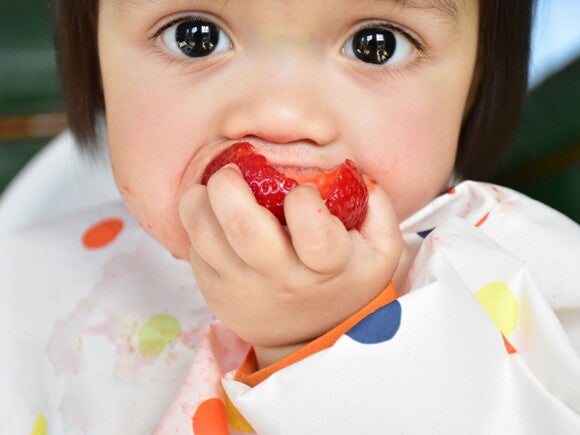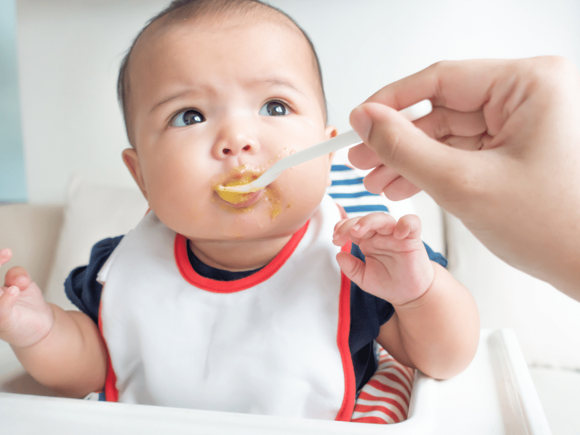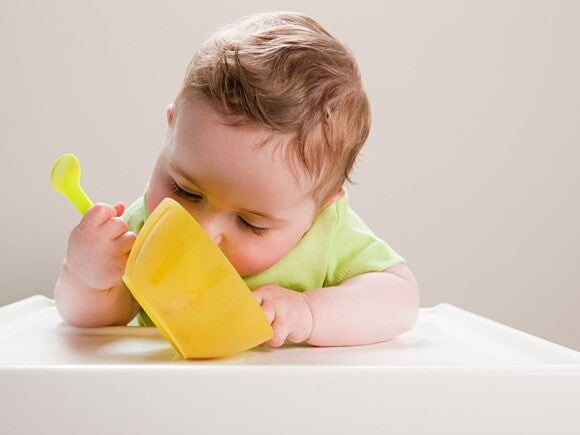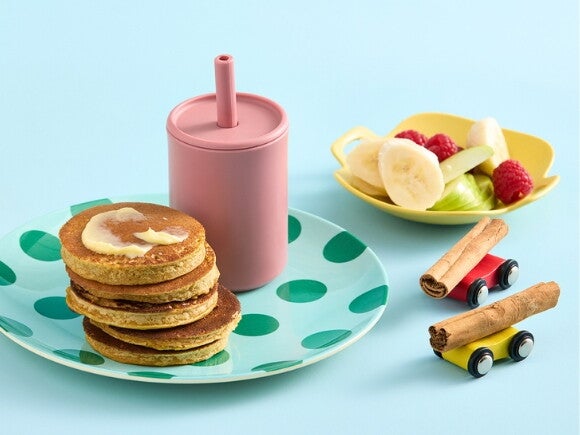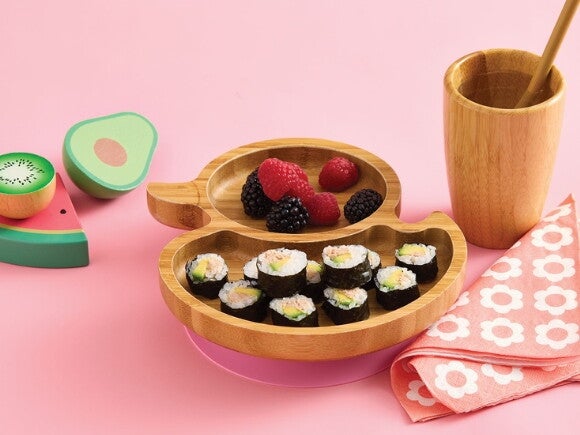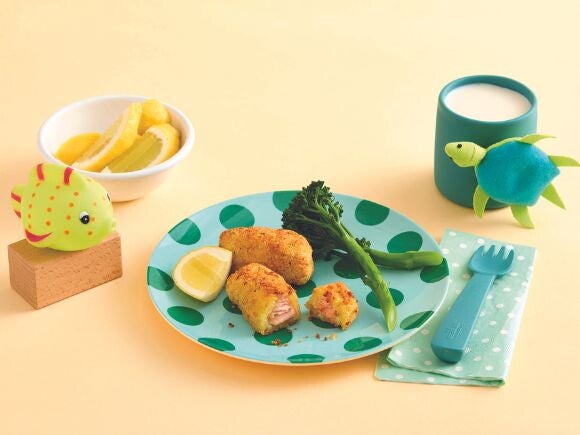Baby led weaning is where you skip the puree stage, and simply jump to the finger food stage. This allows the baby to pick up, touch and play, smell, and taste the usual family foods – such as a thick finger piece of steak, a thick finger piece of soft vegetable, a piece of mango, banana or avocado. Check out our BLW recipes here.
The ideal time to start finger food is when your baby is picking up anything and everything and putting it in their mouth. It is a clear indicator that they are searching for food. Babies also love to copy their older siblings or parents and enjoy being part of meal times with the ability to demonstrate independence with their eating.
How to start baby led weaning
Sometimes this is started by accident especially with subsequent children, as babies love to grab food off their older sibling’s plate. However, ideally this is started at a family mealtime. When your baby is around 6 months of age, they will start to show signs of readiness to start solid food. Start with seating your baby in a highchair at mealtimes when they are able to sit up – when your baby starts showing signs they would like to join in the meal time simply start with offering nutritious size and age suitable foods, such as a softly cooked piece of vegetable off your plate. If you think about it – fingers of nutritious foods are no different to giving your baby a bread-based rusk.
Many BLW first foods have a built-in handle – like a piece of cauliflower or broccoli, a cooked piece of carrot in the shape of a chip or even a little chop to suck on. At first, they might just play with the food, smell it, look at it and then start to suck on it.
It’s advised to also give them soft textured foods as well, especially iron rich foods as babies’ iron stores do start decreasing from birth until they are restored through iron rich foods when solids are introduced. So iron enriched infant cereals, meat and vegetables and mashed foods can still be offered on a spoon, and a variety of textures, colours, temperatures all to follow.
It is important to note here that baby led weaning has nothing to do with your infant weaning from the breast, it is important to continue to breastfeed until at least 12 months of age as it is still an important source of nutrition for your baby. If you do decide to wean from breastfeeding completely before 12 months, a suitable infant formula needs to be introduced. If your baby has not established a good eating and drinking routine by the age of 12 months, then it is recommended to continue breastfeeding or supplementary feeding until you are confident your baby is gaining their complete nutrition from their solid and liquid diet. If you have any concerns about your baby’s diet, consult the expertise of a dietitian or ask your family doctor.
What about the mess? Baby exploring food
All methods of feeding babies is a messy exercise, and BLW may increase this mess, but it is important for babies to feel the texture of foods, and explore foods. Just as playing with toys, paints and dirt, are all messy exercises, they are an important part of growing and developing.
The benefits of baby led weaning
There is much debate about the benefits of BLW and whether they outweigh the limitations. Some of the benefits may include improving your child’s enjoyment in food, their variety of accepted foods, their self-feeding ability and less use of processed baby foods.
On the other side of the coin some of the limitations may include the concern that skipping through the puree stage may affect development of eating and speech; there is a real risk of choking – babies should never be left unsupervised while eating; and that too much emphasis on food being for play up until 12 months of age may impact their nutritional intake – especially of foods rich in iron and zinc which are extremely important for breastfeeding infants as their stores are depleted from birth.
Australian authorities are yet to provide official recommendations for or against baby led weaning. The World Health Organisation continues to recommend starting solids with pureed and well cooked foods.
When not to consider BLW when starting solids
- When your baby is not showing signs of readiness for starting solids;
- Your baby has digestive problems such as reflux, tongue tie, palate problems;
- Your baby is developmentally delayed, perhaps due to being born prematurely or with a disability;
- Your baby has special needs and can’t chew very well, or difficulty picking up foods.
FAQs
What is baby led weaning?
Baby led weaning is an approach to introducing solid foods where babies are encouraged to self-feed from the start, rather than being spoon-fed purees and progressing through different textures. It involves offering age-appropriate finger foods in a safe and supportive environment, allowing babies to explore and develop their feeding skills at their own pace.
When to start baby led weaning?
Wait until your baby is around 6 months of age and showing signs of readiness to eat, such as showing an interest in food, grabbing for food and putting everything in their mouth, being hungry after their usual breast feed or formula feed, and able to sit up with less support.
How to start baby led weaning?
At around 6 months of age, offer age-appropriate finger foods that are soft and easy to grasp, such as cooked vegetables, fruits, and well-cooked grains. Allow your baby to self-feed and explore the food independently and always supervise them to prevent choking. Gradually introduce a variety of foods, textures, and flavours, while continuing to breastfeed or provide infant formula as the main source of nutrition. Be patient and allow your baby to progress at their own pace and consult your healthcare professional if you are concerned. Read our Baby Led Weaning checklist to get started.
Sources:
Australian Government. Get up and Grow - First foods: food from home.
Accessed at: https://www.health.gov.au/sites/default/files/documents/2021/04/first-foods-food-from-home-get-up-and-grow-first-foods-food-from-home.pdf

